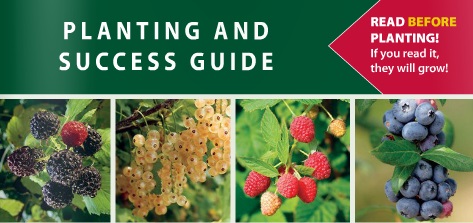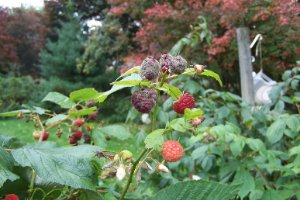Brambles are a high value crop that are very much in demand. Protect your crop investment from these pests.
Like any crop, there are a variety of pests that need to be managed to maximize yields, fruit quality, and extend the life of your planting. Spotted Wing Drosophila (SWD) has quickly became the major pest of fall raspberries – please review past newsletters on our website or contact your local cooperative extension office for specifics on this insect and possible control. Based on grower experience, these are what we believe to be the top five other pests of raspberries.
Pest #1 – Phytophthora Root Rot
Considered the # 1 enemy of raspberries, the wet conditions of 2017 saw an above average incidence of Phytophthora Root Rot, especially on heavier soils and in low-lying areas of fields that are slow to dry. Given that there is very little resistance available in varieties, your best line of defense is good, sound cultural practices -- most importantly, the use of raised beds. These practices start out with a soil rotation plan where you avoid planting back into a prior raspberry site for at least 2- 3 years. Secondly, planting on well drained soils
using raised beds is a good management step to increase drainage in the root zone, particularly for organic growers. For conventional growers, the use of soil fungicide drenches in the spring and fall of Ridomil Gold and Phosphate type materials are helpful in the control of Phytophora Root Rot.
Pest #2 – Botrytis Fruit Rot (Grey Mold)
Another important enemy of raspberries is Botrytis Fruit Rot also known as Grey Mold. Maximizing air drainage in the planting through the use of trellis training, creating an open canopy is an important consideration. Harvesting fruit regularly to not allow overripe or rotten fruit to remain on the plants is a key cultural practice. For organic growers, Oxidate, Sulphur and other products are available. For conventional growers, there a variety of good controls available for use during bloom and in harvest, particularly if there are extended wet periods.
Pest #3 – Aphids
This insect, which congregates on the underside of leaves, is an important vector of virus diseases. Aphids will take in virus from an infected plant and later inject into what was otherwise a healthy plant, where the virus travels throughout the plant creating leaf curl or stunting. Minimize impact by planting virus-free plants and eliminate all wild brambles from within 600 feet of planting. Scouting and controlling aphids when they are first detected in a planting is important for longevity of the planting. For specific pest control recommendations, consult your local cooperative extension office for specific state recommendation.
Pest #4 – Rust Diseases – Orange Rust & Yellow (Fall) Rust
Orange Rust appears late spring or early summer, typically late May – June with orange pustules appearing on lower leaves. Infection comes from plants in field borders and wetlands, especially wild brambles. Though we have seen limited pressure from orange rust in recent years, its critical to identify and control this early – if not controlled, it will go systemic in the plant, kill it and provide inoculum to other plants. Rally, Cabrio and Pristine are main tools for chemical control. Yellow (Late or Fall) Rust appears in August first on lower
foliage and is important to control when first seen as it can spread rapidly during wet periods. We have seen it in grower fields where it will completely defoliate the plant and eliminate harvest. Controls are similar to orange rust – Rally, Cabrio and Pristine.
Pest #5 – Mites
Two spotted mites are the main species of concern but are not a major problem except in tunnel production because of the dry environment. Predator mites are a good, effective control when applied early – 1-2 mites per leaf before they explode into high populations. There are a variety of good chemical controls including Savoy, Brigade and Acramte among others. This year in the Mid-Atlantic region, some growers also saw significant damage from broad mites. This relatively new pest damage is often mistaken for fire blight. The damage begins to show at the top of the plants with very weak growth that then, without appropriate control, travels throughout the plant.
For specific pest control recommendations, consult your local cooperative extension office for specific state recommendation.




